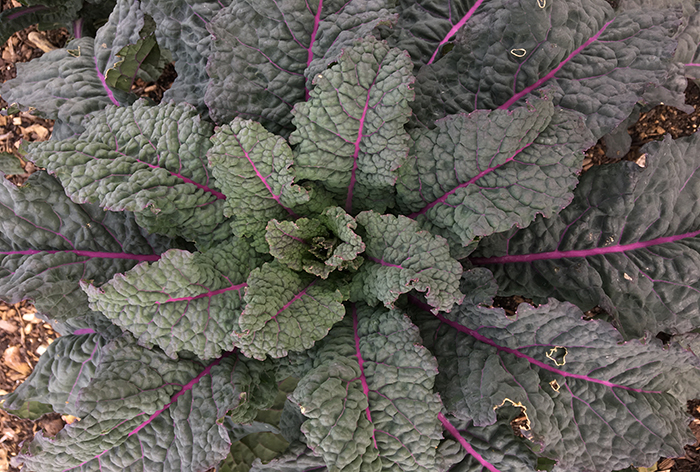Garden Talk
Horticultural Highlight: Kale

In this series, the staff of Duke Gardens highlights plants you’ll find within our 55-acre living collection. This week Doris Duke Center Gardens horticulturist Lindsey Luks features one of her favorite winter vegetables.
Botanical name: Brassica oleracea (Acephala Group)
Common name: Kale
Family name: Brassicaceae
Plant type: Cool season annual
Location in Duke Gardens: Charlotte Brody Discovery Garden, Historic Gardens
Growing up in the South, for me kale was just a garnish on your plate of collard greens, not something that was regularly part of your diet. In the last decade, kale’s popularity has skyrocketed, but if you look back in history, you will find that kale has been around for centuries. Kale belongs to a group of cruciferous vegetables, which are vegetables in the Brassicaceae family. Many cruciferous vegetables share a common ancestor far back in their lineage, but with selection and breeding from people over thousands of years, these plants became their own subsets. Kale, for example, was domesticated, bred and selected for their edible leaves, while broccoli — Brassica oleracea (Italica Group) — was selected and bred for large edible flower buds and stems.
To put it into perspective, kale was first domesticated around 6 B.C. in the Mediterranean region and was widely grown in many parts of Europe centuries before it ever got to the Americas. Thanks to the last decade and good marketing, this superfood is now a common item on menus everywhere. Kale is one of the healthiest foods to consume, being high in vitamins A, K, B6, and C, calcium, potassium, copper and manganese, low in calories, and high in fiber. Kale is also a gorgeous addition to your winter vegetable and ornamental gardens. What a stunning and versatile vegetable!
Kale is a designer’s dream come true. It comes in colors ranging from dark green to red to blue and even silver. As if that weren't enough, the leaves come in a variety of textures. The long and leathery-looking leaves of dinosaur kale make a tall, rigid statement next to the frill and fancy of a curled leaved variety, such as ‘Meadowlark’. There is almost an infinite combination of texture and color associated with kale, and with so much breeding there seem to be countless varieties.One of the most widely grown in the ornamental trade is ‘Redbore’, which has a tightly curled leaf boasting a deep merlot color. Then there’s my personal favorite, ‘Dazzling Blue’, which is a dinosaur kale with deep blue leaves and a bright magenta pink midrib (above).
Another reason kale is one of my favorite vegetables to grow is its superior cold tolerance. Here in North Carolina, kale will go through snow and freezing temperatures, slow down its growth through the winter, and bounce back and continue producing in the spring. Oftentimes we let the butter-yellow flowers emerge in late spring to feed our honeybees, before we pull and compost the plants. No matter what garden aesthetic you are looking for in your winter annual display, there is a kale that will fit in perfectly.
'Dazzling Blue' kale photo by Lindsey Luks.






